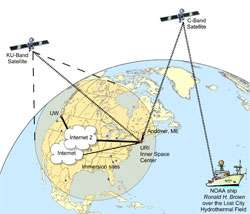A precedent-setting ocean expedition will use “telepresence” to connect Dr. Robert Ballard at sea with Chief Scientist Dr. Debbie Kelley ashore as they explore the unique Lost City hydrothermal vents. The July 23 through August 1 mission is financially supported and coordinated by NOAA, the National Oceanic and Atmospheric Administration.
“Lost City is a remarkable, unique field of tall chimneys that spiral up from the ocean floor, and we are telling its story in real time through a precedent-setting ocean expedition that raises the bar on use of communications technology,” said Ballard, University of Rhode Island oceanography professor and the expedition’s principal investigator. “Normally, on a deep-ocean expedition, I talk with the mission’s chief scientist across a table on the research vessel,” he said. “In this case, we talk across the planet.
“Only now has our nation, led by NOAA, created a major program to explore the vast uncharted regions of our planet that lie beneath the sea, “ said Ballard. “Stay tuned for new discoveries!”
From NOAA ship Ronald H. Brown in the mid-Atlantic ocean, Ballard will communicate with Kelley, who will be in a specially designed command center at the University of Washington. She and other scientists connect to Ballard, and to images from the seafloor, via “telepresence,” using high-speed Internet and satellites. “With teams ashore at the University of Rhode Island and University of Washington, more intellectual capital can be applied to the mission,” said Ballard. In the past, missions have been limited by ship-to-shore communications capacity, the finite number of berthing spaces on research vessels and by competing obligations which sometimes precluded top scientists from going to sea.
“Lost City is truly one of the most remarkable places on our planet. Its serendipitous discovery shows that there is still much left to be learned about our oceans and the life they sustain,” said Kelley, who with colleagues discovered the field of hydrothermal chimneys in 2000, the first of its kind to be discovered. Unlike “black smoker” chimney vents first discovered on the Galapagos Ridge by Ballard in 1977, the fluid venting at Lost City is not driven by heat from cooling volcanoes, but from heat when seawater reacts with rocks below the field
Fluids in black chimney smokers are hot (reaching more than 700°F), but at Lost City vents are cooler (less than 200°F) and are so alkaline they are similar in pH to products used to unclog household drains. Because of its unique chemistry, the field hosts novel life forms that live in the absence of sunlight, and thrive on methane and hydrogen gases given off during alteration of the rocks.
The Lost City vent field is on an underwater mountain the size of Mt. Rainier, on ocean crust about 1.5 million years old. “Because of its unique chemistry and geologic setting, Lost City may be one of our closest analogues to hydrothermal systems active during early formation of oceans on Earth and other planets,” said Kelley.
Source: University of Rhode
























